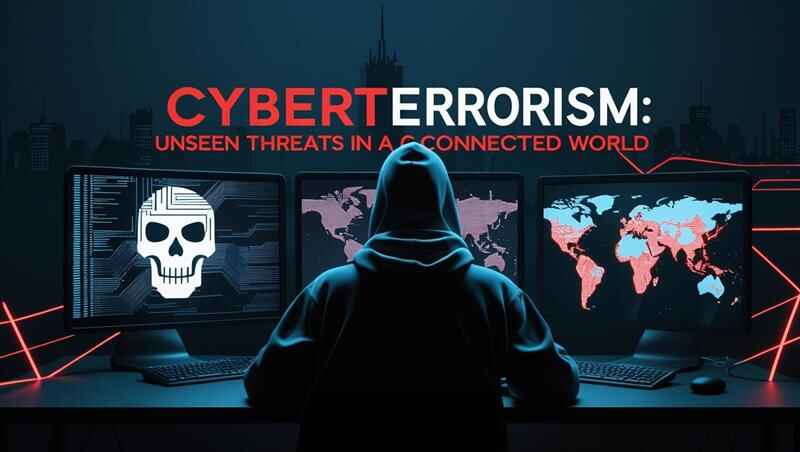In this digitally interconnected world of today, cyberterrorism is one of the most serious threats that individuals, organizations, and governments face. The greater our reliance on technology, the more at risk we are from digital attacks that can interfere with life, economies, and national security. Knowing what cyberterrorism is, how it works, and how to keep yourself or your organization safe is crucial. At UniNets, we provide cyber security training and information security courses that prepare you with the tools required to identify and react to such threats.
What is Cyberterrorism?
Cyberterrorism is the act of using computer networks and web technologies by terrorist groups or individuals for mounting attacks on virtual infrastructure. These attacks are meant to inflict physical destruction, sabotage critical systems, steal sensitive information, or generate fear among the public.
Definition of Cyberterrorism
The definition of cyberterrorism is slightly different for experts, but overall it is used as the politically or ideologically inspired application of computing technology in order to create extreme disruption or damage. It differs from common cybercrimes, which aim for financial benefits, in that cyberterrorism is based on political, religious, or ideological motives.
Cyberterrorism Meaning in Simple Terms
In simple words, the definition of cyberterrorism is applying the internet to conduct attacks that are intended to instill chaos, fear, or material destruction. Some examples are attacking a nation's electricity grid, knocking out airport infrastructure, or targeting banks with the purpose of damaging the economy.
Real-Life Instances of Cyberterrorism Attack
1. Stuxnet Worm Attack
Among the most famous cyberterror attacks was the Stuxnet worm, which was unearthed in 2010. Nation-state actors are suspected to have created this malware that focused on the Iranian nuclear facilities and caused physical harm to centrifuges by manipulating their control systems.
2. Ukrainian Power Grid Hack
In 2015, hackers were successful in disabling part of Ukraine's power grid, cutting hundreds of thousands of people's electricity. This is regarded as one of the first instances of a live cyberterrorist attack on critical infrastructure.
3. WannaCry Ransomware Attack
Although finance-driven mainly, the WannaCry ransomware attack in 2017 had far-reaching impacts on healthcare systems, transportation, and logistics. It infected more than 200,000 computers across more than 150 countries, demonstrating how easily cyberattacks can move beyond borders.
Difference Between Active and Passive Attacks
Knowing active and passive attacks is elementary in cyber security. These two types delineate how a cybercriminal or cyberterrorist operates within a system:
Active Attacks: These entail active manipulation of the system by modifying data or operations. Some of these include DoS (Denial of Service) attacks, malware attacks, and unauthorized data tampering.
Passive Attacks: These attacks do not modify data but entail intercepting or monitoring of communications to obtain information. A good example would be packet sniffing to obtain login details.
The only difference between passive and active attacks is the intent and visibility. Active attacks tend to be disruptive and noticed right away, whereas passive attacks are surreptitious and are designed to gather intelligence without being discovered.
Why You Require Cyber Security Training
As cyberterrorism evolved, individuals and IT professionals should remain ahead of the curve through effective education and skill enhancements. At UniNets, our cyber security training programs are aimed at:
Assist you in comprehending cyberterrorism tactics
Educate the basics of protecting digital infrastructure
Train to detect, prevent, and mitigate threats
Provide real-world examples and hands-on laboratory sessions
New to the discipline or wanting to reskill, cyber security training at UniNets is perfect for becoming a first-line defender against digital threats.
Advantages of Information Security Courses
Along with cyber security, information security training is essential in ensuring data integrity, confidentiality, and availability. Our information security training concentrates on:
Data protection laws and compliance
Threat modeling and risk analysis
Secure system development
Defense mechanisms against active and passive attacks
Information security-trained professionals are more able to manage cyberterrorism attacks, insider threats, and data breaches.
The Role of Cyber Security Courses in Combating Cyberterrorism
As cyberterrorist organizations transform, so should our defense measures. Cyber security training does not only teach students about the technical aspects of cyber protection but also sensitizes them to the psychological and social effects of cyberterrorism. Some of the topics discussed in these training sessions are:
Network security and firewall setup
Intrusion detection systems
Ethical hacking and penetration testing
Incident response and disaster recovery
At UniNets, we combine theoretical education with practical training so that our students become employment-ready and proficient in securing contemporary IT infrastructures.
Why Go With UniNets for Cyber Security and Information Security Training?
UniNets is a well-established brand in the IT training segment, renowned for its superior quality, hands-on, and certification-aligned learning solutions. Here's why we stand apart from the rest:
Expert Faculties: Educated by certified and skilled trainers.
Live Projects & Labs: Practice in actual situations.
Flexible Learning Modes: Online and classroom training are available.
Industry Certifications: Get certified for globally accepted certifications like CEH, CISSP, and many more.
Whether you wish to learn about the meaning of cyberterrorism, identify active and passive attacks, or become a certified security professional, UniNets has the correct course for you.
Final Thoughts
In an age where danger can originate from a keyboard a thousand miles away, knowing about cyberterrorism is no longer a choice—it's a must. With attacks happening in real life against infrastructure, healthcare, and finance, the demand for knowledgeable cybersecurity professionals has never been higher.





Comments